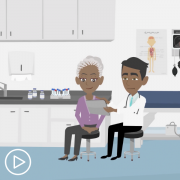How to Thrive and Set Myeloma Treatment Goals
How to Thrive and Set Myeloma Treatment Goals from Patient Empowerment Network on Vimeo.
Myeloma expert Dr. Joshua Richter discusses the benefit of setting myeloma treatment goals with your healthcare team.
Dr. Joshua Richter is director of Multiple Myeloma at the Blavatnik Family – Chelsea Medical Center at Mount Sinai. He also serves as Assistant Professor of Medicine in The Tisch Cancer Institute, Division of Hematology and Medical Oncology. Learn more about Dr. Richter, here.
Related Programs:

|

|

|
Transcript:
Katherine:
Excellent. Since this webinar is part of Patient Empowerment Network’s Thrive series, I thought we could start by getting your opinion on what you think it means to thrive with myeloma.
Dr. Richter:
Absolutely. And I love that term. I recently chaired a 5K walk for the MMRF, and the word that is thrown around a lot in cancer is “survivorship.” And, I got up there and I said, “That’s not a word I like to use. I like to use the word “thrivorship.” So, I love that you’re using this word because to me, surviving is an important part of dealing with cancer, but it’s the first step. Thriving is the goal. The goal is not to just get through it. It’s to go beyond it. It’s to do everything you want to do in life: personal, family, business, anything you want.
If you want to spend your time fishing, if you want to spend your time skydiving, if you want to spend time with your grandkids, and enjoying that time, and as much as humanly possible, keeping the notion of cancer way out of your brain. To me, that is thriving and not just surviving with a diagnosis like myeloma.
Katherine:
That helps us guide through the conversation as we continue on. Getting the appropriate myeloma care is, of course, part of thriving. So, let’s talk about treatment. How would you define treatment goals?
Dr. Richter:
Sure. So, treatment goals are different for each different individual because unfortunately, myeloma tends to affect people who are older. So, whereas the goals for an 85 or 90-year-old diagnosed with the disease is maybe things like, “I don’t want to suffer. I don’t want to have as many side effects,” but the goal is not to live 40 years, that’s different from a 40-year-old who may say, “I’m willing to tolerate certain side effects because I want to live as far as possible.” So, in reality, there always has to be this huge balance. And as with anything in medicine, an open dialogue with your care team is crucial to understand what your goals are because a lot of us make assumptions on both sides.
The patient may assume that we want certain things out of this. We may assume the patient wants certain goals. Really open, vibrant discussions where there are no taboos, there’s nothing wrong to say. I’ve had patients say, “I don’t care what happens. My granddaughter is getting married next year. I need to be there.
Anything beyond that, I don’t care.” That’s their goal. They’re entitled to their goal. I will work with them within that construct. So, really being open about what the goals are. Right now, what I tell patients is, especially for younger patients who if you’re already 85 or 90, you’re getting closer and closer to how long you’re likely to survive even without myeloma.
It’s kind of hard to have a 90-year-old have a 30-year survival. We’re not living to 120 just yet anyway. But for most of my patients, I say my goal is to either keep you in remission so long that you pass from something else many years from now, or to keep you moving until we have a cure that we can just give you and then make sure that that cure, that you’re able to accept it. That your body’s intact, your bone marrow’s contact, and this is something we can provide for you.






